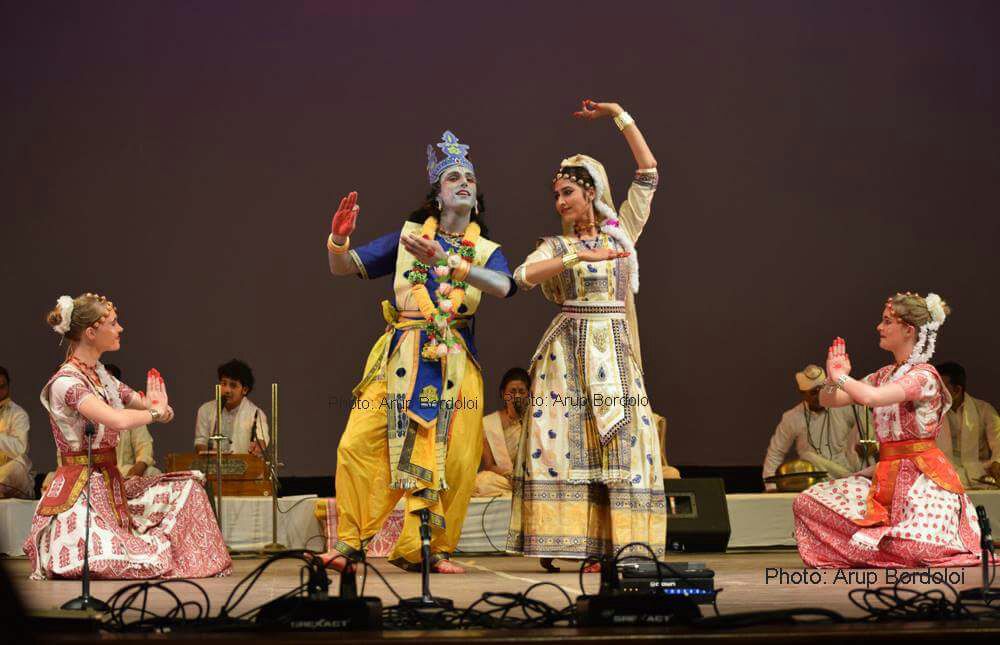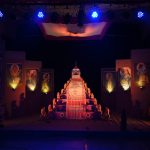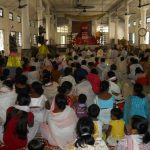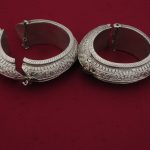The performance of the Ankiyā plays authored by Srimanta Sankaradeva and Madhavadeva is known as Bhāonā. Many plays have been written since then by different Assamese playwrights in the style of the Ankiyā plays composed by these two doyens of Assamese literature and culture. But these later compositions are not called Ankiyā play. So Ankiyā Bhāonā indicates the enactment of only the Ankiyā plays authored by Srimanta Sankaradeva and Madhavadeva. There are many special characteristics of Ankiyā Bhāonā. These are evident in the content of the play, dialogues, costumes, ornaments, entry and foot-steps of the characters. These characteristics not ony differentiate Ankiyā Bhāonā from other plays, but also help the audience of Ankiyā Bhāonā to differentiate the characters of the play from one another. I will discuss the characteristics and origin of the costumes and ornaments worn by the characters of Ankiyā Bhāonā in this paper. The costumes and the ornaments constitute the Alankāra of the play. But it is not possible to discuss all costumes and ornaments in a single paper, which is a subject of full-scale research. I will discuss only a few important costumes and ornaments here.
Costumes of Sutradhara and Gayan-Bayan
An important costume in the Ankiyā Bhāonā is the headgear which is called Pāg or Pāguri in Assamese. Different types of headgears are worn by different characters. The most important character and compere, Sutradhāra wears a Sutradhāra Pāg popularly known as Moglāi Pāg though it is a wrong name. Actually it should be called Koshāpatiyā Pāg as the Pāg is prepared by tying the cloth in a Koshā. As per the legend, the Koshā is a vessel for washing the feet of Ishwara. The Kamalabari Sattra has preserved a 356 year-old wooden Koshā. Thus the Sutradhāra Pāg symbolizes the blessing of Ishwara on the Sutradhāra. Interestingly the character of Indra also used to wear Koshāpatiyā Pāg in the Kamalabari Sattra in the earlier days.
The Sutradhāra Pāg varies from one place to another in Assam due to local influences and innovations by the concerned Sattras. This may have also happened as Srimanta Sankaradeva and Madhavadeva had to migrate and live in different places of Brahmaputra valley due to royal persecutions in different periods of their lives, consequent upon which different changes were probably incorporated in the costumes in those places. The Sutradhāra Pāg is known as Thukurā Pāg in the Kaliabor area of middle Assam. They too have a wooden frame to construct the Pāg. It is also known as Koldiliyā Pāg in many places due to the fact that its shape resembles that of Koldil (the flower of banana tree). Sometimes the Sutradhāra Pāg is embellished by adding laces on the borders. This lace is similar to that of Cheleng.
The headgear of Sutradhāra is different from that of Gāyan-Bāyan (singers & instrumentalists). The Gāyan-Bāyan wear Khekerupatiyā Pāg or Gosāi-Pāg as headgear. The Sutradhāra Pāg covers most of the forehead, while the headgear of Gāyan-Bāyan does not. However Krishna and the royal characters do not wear headgears. They wear crowns made of bamboo sticks and cane fibre. But over time, the crowns started to be made of paper pulp covered by cloth, which is embellished by Chumki and lace. Earlier, Kingkhāp was used in the crowns, but now velvet is used. The crown is of two types, Mukut and Kiriti. The Mukut is large and is worn by the kings. The Kiriti is small and is worn by the queens too. The Kiriti of Krishna is embellished by the feather of peacock. However this feathered crown is used only during the childhood of Krishna. The grown-up Krishna does not wear feathered crown as the feather happens to be a part of his childhood frolick only.
The Sutradhāra wears a loose jacketed vest on the upper part of body. This jacketed vest is popularly known as Jālikotā Cholā as there is a netting added and sewn above the open-chest cloth vest. Other characters also wear jackets in Ankiyā Bhāonā. In their case, the jacket is separate and not sewn onto the Chāpkon. Moreover their jackets happen to be coloured. The Ghuri or Lahangā worn by the Sutradhāra is a type of petticoat that reaches upto the ankles. A waist-band called Karadhani used to be put on by the Sutradhāra around the waist. This kept his Jālikotā Cholā and Ghuri or Lahangā together. But it has become almost extinct. Moreover it is costly. So alternatively a cloth waist-band called Tangāli is used. This is necessarily white, while the Tangāli used by the folk Bihu dancers is red. The Karadhani or Tangāli is interspersed by flowery designs. These may be coloured in the case of Tangāli, generally red. Over and above all these, the Sutradhāra hangs two long pieces of clothes from his two shoulders down to knee, taken through under the Karadhani or Tangāli. The entire attire of Sutradhāra is made of natural silk. But cost consideration has compelled people to go for artificial silk. Some people go for cotton cloth also. The colour is necessarily white.
The Gāyan-Bāyan (singers & instrumentalists) do not wear dresses like the Sutradhāra. They wear Chāpkon reaching upto knees, a Cheleng over that, simple Dhuti and a Khekerupatiyā Pāg or Gosāi-Pāg as headgear. Earlier their attire used to be made of natural silk. But now-a-days it is made of cotton. Every thing they wear is pure white, which signifies spiritualism and the pure individual self. The entire recital by the Gāyan-Bāyan is a prayer by the individual self to the universal self. So there is no colour, no embellishment. The headgear is decorated by a garland of Bakul flower or Tulsi rosary. It is given by the Sattrādhikār as blessing. The head Bāyan who is known as Borbāyan wears a rosary of beads in his neck. The entire performance of Gāyan-Bāyan is a spiritual service. Earlier they used to wear Gām Khāru, Moni etc like Sutradhāra. But that practice has been stopped. Of course sandalwood Tilak is a must for every one on the forehead.
Costumes of Krishna and the kings
The costume of lord Krishna in Ankiyā Bhāonā is noteworthy. Krishna wears yellow Dhuti which is called Bhuni in Sattriyā jargon. The Gopa boys also wear yellow Bhuni. Additionally, Krishna wears a Banamālā in his neck. It is indicative of the five elements, which are his creations. The royal characters wear Chāpkon and hang a decorated piece called Nimāi from the neck in both front and back. The Chāpkon is full-armed and coloured. The Nimāi over it is made of velvet and decorated with lace etc. They wear coloured Dhuti. Some of the characters wear a flowing cloth on their back. It is called Pithiyā. The actors playing the characters of Krishna and the kings wear Pithiyā. Now-a-days the Pithiyā of Krishna is sought to be differentiated from other Pithiyās by writing an Om on it.
The characters of Seers like Vishwamitra, and Parashurama wear ochre coloured clothes in Ankiyā Bhāonā. All of them wears simple Dhuti and Cheleng. This costume of the ascetics is different from the rest of India where the characters of Seers or Sanyasins wear either flowing robes in Persian style or mere Kaupin as their formal dress. Vishwamitra and Parashurama wear a small Dhuti in the style of Kaupin in Ankiyā Bhāonā. Their Kaupin extend upto the knees, unlike in the rest of India where the thighs of the characters remain exposed. The Cheleng also is unique for Ankiyā Bhāonā. The Vaishnavite seer Narada wears white Dhuti and Cheleng. He carries a Veenā in his hand and wears a garland. Vishwamitra carries a Kamandalu (water-pot) and a Yogadanda (arm-rest) in his hands and wears matted hairs. Parashurama carries a Kamandalu and an axe in his hands and wears matted hairs. Both of them wear garlands of Rudrāksha beads around neck as well as the wrists.
Costumes of the female characters
The female characters wear Mekhelā and Rihā if they are royal characters. Otherwise they wear Ghuri, Chādar and Kurmani or Kācholi if they are general characters or dancing damsels. Their Ghuri has two inch broad lace borders made of golden thread called Gunā. They drape the Kurmani or Kācholi by the Chādar which is put across the chest. Two long clothes are additionally hung from two shoulders like that of Suttradhāra. All these apparels are decorated by flowery designs. But that is optional. The married characters cover their heads with veil called Orani. But the queens do not take veil. Actually all female characters should take veils according to Nātyashāshtra. So it is a clear deviation of Srimanta Sankaradeva from the Nātyashāshtra tradition. He had departed from Nātyashāshtra in many places of his Ankiyā plays and developed his own characteristics. This is one such example. Some female characters hang Nimāi-type decorated piece from their waist-lines. The hair is tied to a knot called Khopā. In earlier days the female roles were played by males. So they needed extra hair, which was prepared from jute. The artificial breasts were made of wood.
Ornaments
Regarding ornaments, the Sutradhāra wears earings known as Kānphuli or Lokāpāra in his ears. He hangs Motāmoni, Dugdugi etc from his neck. He wears bracelets called Motā Gām Khāru in his wrists. Some bracelets have the motif of Magar. He also wears Nupur that makes rattling sound on his legs. In the earlier days he used to wear a silver waist-band called Karadhani around the waist. The kings and deities wear Chandrahār around the waist. The female characters wear Bāju in the arms, gold bracelets in the wrists, earings in the ears, necklace like Golpotā in neck, gold rings in the fingers, and gold tapering called Jethi on the forehead, etc.
Make-up
There were indigenous techniques for make-up too. In the past the Sutradhāra used to redden his lips with a herb named Barhamthuri. But modernization has driven such practices away. Lipsticks have taken its place. Regarding facial make-up, it has to be Gaura or pale red colour for the Sutradhāra. A Tilak of white sandalwood paste is put on his forehead. Different characters are given make-up in keeping with the nature of the characters. For instance, cruel persons like Jarasandha, Shishupala, Taraka etc are given black make-up. Angry characters like Vishwamitra, Parashurama are given reddish make-up. Innocent characters like the Gopis, the Gopa boys etc are given white make-up. Spiritual characters like Krishna, Rama etc are given Shyāma or greeenish black make-up.
As many as twenty one ingredients were used for the make-up of the actors in Ankiyā Bhāonā. The most important among these were vermillion, indigo, lime and yellow ochre. The minor ingredients included mollases, soap-nut, yolk of the egg, the seed of the Ou fruit, the gum of the Bael (Aegle Marmelos Corr) fruit and Tamarind seeds, the juice of earthworm, charcoal of dry gourd, lamp black, sand etc. However these raw materials have been dispensed with in the modern times as different face-paints are now readily available.
Ethnic sources of costumes
Srimanta Sankaradeva and his followers incorporated ethnic elements of Assam in the Aharya of Ankiyā Bhāonā. This incorporation was a process of sanskritization of the ethnic groups of Brahmaputra valley. Srimanta Sankaradeva led that sanskritization process. It may be mentioned that Assam was known for different ethnic conflicts when Srimanta Sankaradeva was born here in the fifteenth century. The main ethnic groups are Karbi, Ahom, Kachari, Chutiya, Koch, Mising, Barahi, Moran, Matak, Deuri, Rabha, Tiwa, Kalita, Kayastha, Bodo, Hajang, Garo, Dimasa, Brahmin, Kaivarta, Daivajnya, Kumar, Bonia, Mech, etc. The saint felt the necessitry of bringing these ethnic groups together. Culture was the fittest medium for that. This thinking of Srimanta Sankaradeva is reflected in the incorporation of ethnic ingredients in costumes and ornaments of Ankiyā Bhāonā. He did this in such a perfect manner that the folk ingredients gave rise to a classical asset. He was a great textile designer as reflected by his creation of the famous Vrindāvani cloth depicting the life of lord Krishna, which is presently preserved in London and Paris.
I have already said categorically that the costumes of Ankiyā Bhāonā were mostly derived from indigenous origin. They certainly reflect local traditions. For instance, the Sonowal tribe has a tradition similar to that of Gāyan-Bāyan. So it may be surmised that the costume of Gāyan-Bāyan was influenced by the costumes of Sonowal tribe. But it does not include the Pāg. The Pāg of Gāyan-Bāyan was not influenced by the Sonowal tribe.
The jacket of Sutradhāra is styled after the jacket worn by the tribal groups of Assam. Tribes like Tiwa, Mising etc wear a colourful jacket as a festive cloth. The jacket worn by the Sutradhāra is not colourful, but the basic design is like the ethnic jacket popular in the Brahmaputra valley. There is difference in the jackets of other characters too from the ethnic jackets. The difference in the jacket of Ankiyā Bhāonā from the ethnic jacket is that of difference of classical from folk element. Every thing has been refined here.
The tradition of wearing Ghuri or Lahanga worn by the Sutradhāra was probably derived from the indigenous Ojāpāli. The Naganyā Ojāpāli mainatained it till the other day. I had the priviledge of witnessing the recital of late Maheswar Ojha of Nagaon. His costume had uncanny resemblance with that of Sutradhāra. It is however difficult to determine the direction of influence, whether it was from Sutradhāra to Ojā or from Ojā to Sutradhāra.
The Rabhas also wear dresses resembling the Pāg, Jālikotā Cholā, Ghuri, and Tangāli, of the Sutradhāra in their Bāikhu dance. The Jālikotā Cholā worn by Sutradhāra is also similar to the Khangāliphagā of the Tiwa tribe. The Tangāli used by the Sutradhāra and other characters was a tradition of the Bhuyans themselves. It is significant because both Srimanta Sankaradeva and Madhavadeva were Bhuyans. They thus retained a heritage of their own community. Tangāli became very popular all over the valley and hence it was adopted by the Bihu dancers too. Even the Ahom kings, well-known for their aesthatic sense adopted it.
The Sutradhāra Pāg is actually an indigenous style that was refined by Srimanta Sankaradeva. Some people have wrongly termed it as Moglāi Pāguri and opined that it had been derived from Northern Indian source. Actually it was an innovation by Srimanta Sankaradeva, based on ingredients from ancient traditions and the costumes of the Jaintia and Dimasa tribe. It is erroneous to call the Sutradhāra Pag as Moglāi Pāguri. The nomenclature Moglāi is not correct. It so became as some people mistakenly thought it to be an import from the Mughal culture. Actually it is an indigenous tradition. A somewhat similar headgear is found in an ancient Assamese sculpture of the Mahisha demon recovered from Tinsukia. This sculpture belongs to either twelveth or thirteenth century. So the Sutradhāra Pāg of Ankiyā Bhāonā is an indigenous tradition.
The Khekerupatiyā Pāg or Gosāi-Pāg of Gāyan-Bāyan too is also seen among the indigenous people. The headgear used by the artists in Srimanta Sankaradeva’s plays was an ancient heritage of Assam. Moreover the very practice of wearing headgears was a heritage of the Eastern India, from where it spread to other parts of India. The concept of headgear itself had been imported by the Mughals from eastern India. So I would rather say that Mughal emperors adopted the style of headgear worn by the Sutradhāra in the Ankiyā plays of Srimanta Sankaradeva. This cultural exchange took place via the Koch kingdom. A direct and close relationship was established between the Mughal kingdom and the Koch kingdom during the period of king Akbar.
Ethnic sources of ornaments
Almost all the ornaments of Ankiyā Bhāonā except the Nupur and the Chandrahār, which are all-India heritages, have been derived from folk culture of Assam. All these ornaments are popular among the ethnic groups of Assam. The motif of Magar in bracelet is a Thai tradition probably brought by the Ahoms. The Gām Khāru is a local tradition. The Mising tribe ad the Chingphow tribe call their headmen Gām. That is how the traditions came to the common Assamese culture. The Gām Khāru is very common in Assam and a variation of it is worn by the Bihu dancers too. However the Gām Khāru worn by the Sutradhāra is different from the Khāru worn by the Bihu dancers. The Khāru worn by the Bihu dancers is broader than the Gām Khāru worn by the Sutradhāra. The Khāru worn by the Bihu dancers is called Potiyā Khāru, not Gām Khāru. Some of the Sattradhikārs also used to wear Gām Khāru in earlier days.
Observations
The costumes of Ankiyā Bhāonā are quite distinctive. These have some unique characteristics. For instance, the costume of the Sutradhāra is unisexual. While the audience can differentiate all other characters as male or female from the costumes, they cannot do so in the case of Sutradhāra from the costume. It is because this character is defined after Ishwara or the universal self, who runs the entire show of this universe. Sutradhāra means one who holds the thread. It is he who holds the threads of all our lives. Ishwara is the real Sutradhāra. And Ishwara is beyond sex. So the cosume of Sutradhāra does not reflect any sex.
The Om on the Pithiyā of Krishna is not in tune with the philosophy of Eka Sarana propounded by Srimanta Sankaradeva. The Om is considered to be an icon in Maitrāyani Upanishada. That is why there is no mention of Om in Srimanta Sankaradeva’s writings, which preaches an iconless system of worship. Adding an Om would distort that ideology. I do not think it is proper to add Om. It must be dispensed with. Moreover lord Krishna himself is attributeful universal self. To scribble an Om that represents an icon of the attributeless universal self on the attributeful universal self is utterly confusing. It is also a gross act. No character carries a name-plate in any play. Actually the Pithiyā itself is an aberration, as it is an external element that crept into the costumes of Ankiyā Bhāonā through the outside suppliers of costumes. The costumes of Ankiyā Bhāonā have suffered from many such distortions. Certainly the Pithiyā is one such costume. It should be altogether given up.
The decorated piece called Nimāi put over the Chāpkon worn by the royal characters and hung from the waist-line by the female characters also appears to be a later day addition and an import from outside. It does not reflect the spirit of Ankiyā Bhāonā. I consider it a vulgarization of the Sankari tradition. Probably this style was incorporated during the post-Sankaradeva era, when Mughal influence became prominent a la the Ahom kings. Some of the Sattras became much dependent on royal patronage, which told on the cultural elements too. It is too gross. It should have been much subtler in order to reflect the true spirit of Ankiyā Bhāonā. Vishwamitra and Parashurama wearing the Dhuti in the style of Kaupin is also not in tune with the aesthatics of Ankiyā Bhāonā.
The changes incorporated in costumes of Ankiyā Bhāonā are not always praiseworthy. For instance the use of velvet cannot be called a good change. Use of velvet instead of natural silk and cotton for making the attires is a distortion. It should not have replaced cotton and natural silk. Actually the whole selection of materials was made on cost consideration and local availability of raw materials. The entire system preached by Srimanta Sankaradeva and Madhavadeva was such that people at large could afford to procure the inexpensive and locally available raw materials. That was why the use of cotton fabric was predominant, while options were kept open for natural silk too. But the introduction of velvet has left no alternative as no other fabric can be used as its substitute. The introduction of velvet has made the preparation of costumes an expensive affair and the enterprise of costume making has been wrested by commercial firms from lay public. Incorporation of velvet is vulgerization of the aesthatic costumes of Ankiyā Bhāonā. Such vulgerization and corruption of the indigenous traditions should be discouraged. Classical things are done according to a design, according to a grammar, dictated by some principles. One must abide by these principles. So it is necessary to rescue the costumes of Ankiyā Bhāonā from vulgerization and corruption. Moreover it is an external influnece. So it should be dispensed with. We can use the indigenous Kingkhāp instead of velvet if at all such decorative clothes are necessary. Similarly the practice of wearing imitation jewellery or ornaments of non-Assamese origin by female characters also has to be discontinued.
Another external influence that needs correction is the use of Jāmā or Mirzāi Cholā by the royal characters. It was derived from Mughal tradition when the Ankiyā Bhāonā were presented before the Ahom kings by some Sattras campaigning to derive royal patronage. The introduction of blouse is also a similar later entry. The pure indigenous tradition permits wearing of bodice, which ie worn by the old ladies even today. However blouse can be accepted as a refined version of bodice as long as it is long enough to cover the navel area. But I have seen open navel area in recital by some female artists. This should not happen. It is not in tune with the Sankari culture.
The use of modern make-up has become essential due to the non-availability of the indigenous ingredients. I think this change may be accepted as long as the modern make-up brings out the colours created by the indigenous ingredients. Moreover the indigenous ingredients should be used whenever possible because it is important to preserve the classical traditions. Only these make -up should be used in lesser proportion as the strong lighting arrangements in the modern stage has made heavy make-up unnecessary. In the medieval period, the make-up had to be very heavy as lighting arrangement was done by lamps of mustard oil. If performance is done in that manner any time for academic reasons, heavy make-up will again be necessary.
Regarding the colours used in the costumes of Ankiyā Bhāonā, we find a plethora of colours. There are white, yellow, red, blue, ochre, green, black etc. They are used as per the nature of the character who wears it. Now-a-days colours like violet also are used. But it does not go well with Ankiyā Bhāonā. The choice of colour happened to be mostly from the primary colours. Deviation from that principle does not fit well with the system. The choice of colours is very important in Ankiyā Bhāonā. The costumes of Gāyan-Bāyan must be white as they render a prayer to Ishwara. The costumes of Sutradhāra are also generally white. But these costumes can have a tinge of light colours like pink, sky blue etc because this character is neutral and at the same time representative of Ishwara. We can go that far for the sake of modernization and no further.
Earlier published in www.sankaradeva.com




